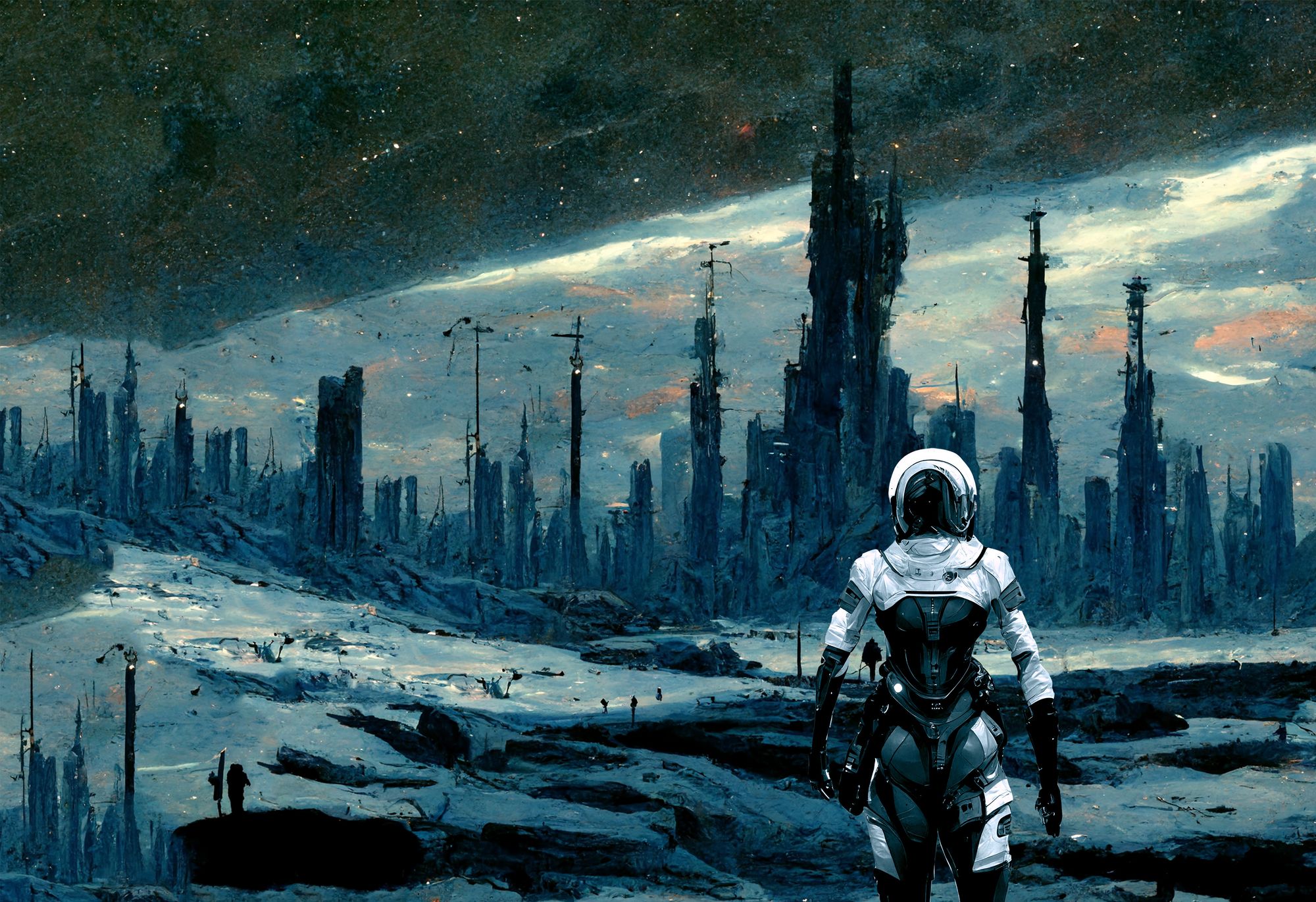First, a preamble. If you're not interested in the thought that goes into choosing cover art, click here to go to see just the new cover and synopsis!
"Don't judge a book by its cover," they say. Well, I don't know about you, dear reader, but I absolutely judge books by their cover. It's not a perfect indicator for how good the story inside is going to be, true. But it is a pretty good sign of how much the author believes in their work.
Writing is cheap. Publishing is expensive. If you see a gorgeous self-published book cover with custom illustration, know that the author has poured significant financial resources into it. If they've done that, they probably believe their book is good enough to earn back that investment. How much effort an author put into their cover is a proxy for how much effort they put into all the other aspects of the process. An imperfect proxy, to be sure, but it's at least somewhat reliable.
A significant reason for that proxy's unreliability is because of money. I'm sure there are countless authors who have poured their soul into the story, but then couldn't afford to commission an artist for the cover. You can write a book in Scrivener for $50. You can subscribe to Microsoft Office and write it in Word for $8/month. You can write in notebooks bought at Target for $1 each. You can do it in Google Docs for free. There are tons of great options out there for writing, and they're all pretty inexpensive.
Like I said, writing is cheap. However, when it comes to cover art, there are no real cheap options. Premade cover art ranges somewhere between $100 to $600, but the tradeoff is that you don't get to decide exactly what's depicted. You'll have to scour the galleries for something that fits your story and may not be happy with what's available. The lower your budget for artwork, the more limited your options.
On the other end of that spectrum, a talented artist may charge thousands of dollars for a commission. You'd better hope your book sells well, otherwise you'll have a really hard time earning out. The artist is often worth the price, however, because (with luck) good cover art can contribute greatly to sales.
So, that brings me to Grave of the Waiting. What route did I choose to go down? If you haven't seen the cover already, have a look:
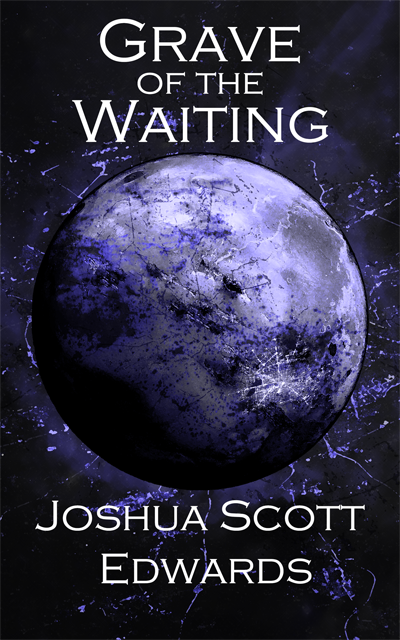
I went with premade art, with a catch. I paid $0 for it, because it was premade by me. Several years ago, I designed the album art for my band gravelord's debut album:

I reused the planet artwork because I wanted the serial to have some tie-in to the band and I figured it fit well enough. It certainly wasn't the most eye-catching book cover, but I wasn't too concerned.
But if cover art is an indicator for how much effort the author puts into the story, there's a huge mismatch here. Grave of the Waiting has been my main writing project for all of 2022, and I've spent upwards of 280 hours on it. For comparison, from halfway through the 1.0 draft of An Ocean of Others (when I started tracking my hours) to the 6.0 draft and beyond, including all of the marketing and formatting, I've spent only 277 hours, and I still feel like I'm putting tons of effort into that book. (Sci-fi is hard... Harder than fantasy, let's fight about it.)
Okay, so I've spent an egregious amount of time writing Grave of the Waiting, but the cover art stinks. Time to correct that. Only one problem: I don't have any budget to commission an artist, partly because I spent a considerable chunk of change on the artwork for An Ocean of Others, and partly because this is a free story I'm giving away on my website.
The solution: something that seems like science fiction, only it's real – AI generated art.
Let's take a look at the art (and the new synopsis I wrote to go along with it), then I'll talk about the process I used to create it and some concerns you may rightfully have.
Grave of the Waiting New Cover Art
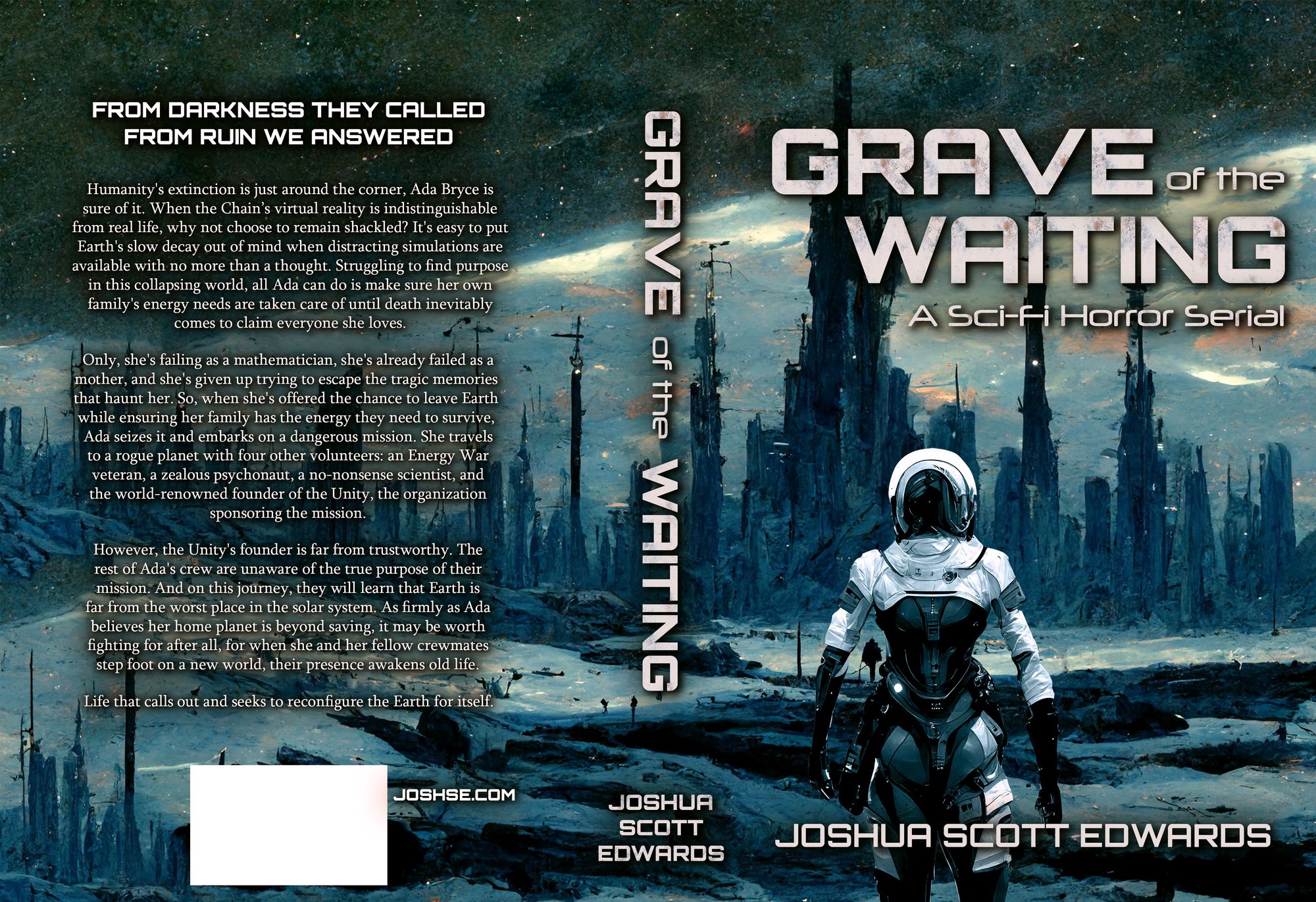
FROM DARKNESS THEY CALLED.
FROM RUIN WE ANSWERED.
Humanity's extinction is just around the corner, Ada Bryce is sure of it. When the Chain's virtual reality is indistinguishable from real life, why not choose to remain shackled? It's easy to put Earth's slow decay out of mind when distracting simulations are available with no more than a thought. Struggling to find purpose in this collapsing world, all Ada can do is make sure her own family's energy needs are taken care of until death inevitably claims everyone she loves.
Only, she's failing as a mathematician, she's already failed as a mother, and she's given up trying to escape the tragic memories that haunt her. So, when she's offered the chance to leave Earth while ensuring her family has the energy they need to survive, Ada seizes it and embarks on a dangerous mission. She travels to a rogue planet with four other volunteers: an Energy War veteran, a zealous psychonaut, a no-nonsense scientist, and the world-renowned founder of the Unity, the organization sponsoring the mission.
However, the Unity's founder is far from trustworthy. The rest of Ada's crew are unaware of the true purpose of their mission. And on this journey, they will learn that Earth is far from the worst place in the solar system. As firmly as Ada believes her home planet is beyond saving, it may be worth fighting for after all, for when she and her fellow crewmates step foot on a new planet, their presence awakens old life.
Life that calls out and seeks to reconfigure the Earth for itself.
The Process
So, first things first, I'm under no illusion that this is as good as it would be if I commissioned a professional artist. Not even close. I even chose not to paint out the little splotches that are a dead giveaway of AI art because I thought it was appropriate for a story in which artificial intelligence plays a key role to be represented by a largely untouched AI generated piece.

Okay, it's not entirely untouched. It involved a decent amount of compositing. Here's how I created it.
First, I signed up for Midjourney and started generating images I could use for the background. This was just a bunch of trial and error with prompts including things like "icy landscape", "alien cyberpunk city", "craters", "starry sky", etc. in some combination.


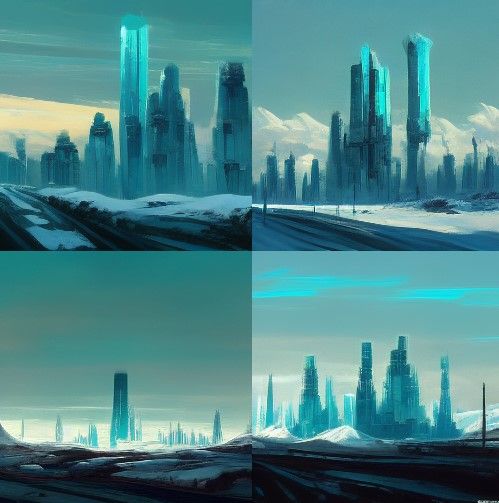

Most of them didn't have the look I wanted, but after about 15 minutes I got one with a sky I liked that had the sort of decaying city and color palette I was going for. I upscaled this to max so I'd have a high-resolution version of it for the background of the cover art.

I loaded the upscaled image into Photoshop, cropped it, threw some text on it, and within 30 minutes of starting I sent this prototype to my friends on Discord:

That's very bare bones, but I'd say even that's an improvement over the original. But I wasn't done yet. I knew I wanted a subject in the foreground. At first, I envisioned this as a group of five astronauts walking toward the city, but I couldn't get the AI to create a group that looked right. So, I changed tack and went for one female astronaut to represent Ada on the cover. Classic design, put your protagonist on the cover, front and center.
And here we run into currently the biggest pitfall with AI generated art. No matter what prompts I tried, I couldn't get it to create an astronaut that looked like Ada in the pose I wanted. Sort of like premade art, you're at the mercy of what's available. In this case, what's available is whatever the AI happens to spit out as it interprets your prompt with frustrating degrees of inaccuracy.
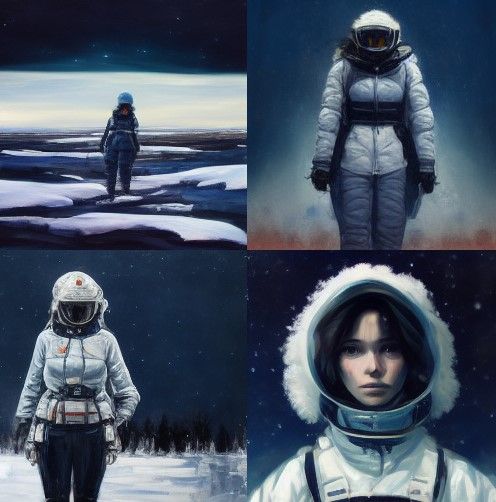
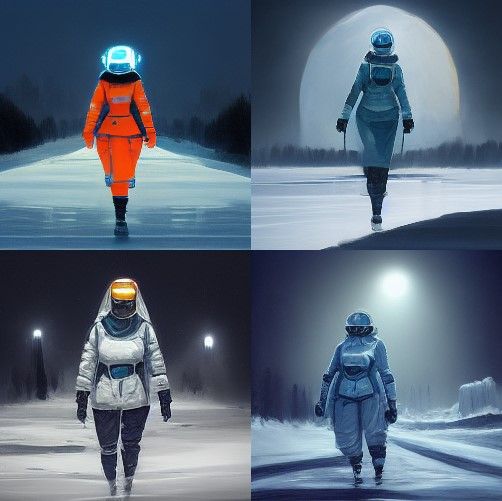

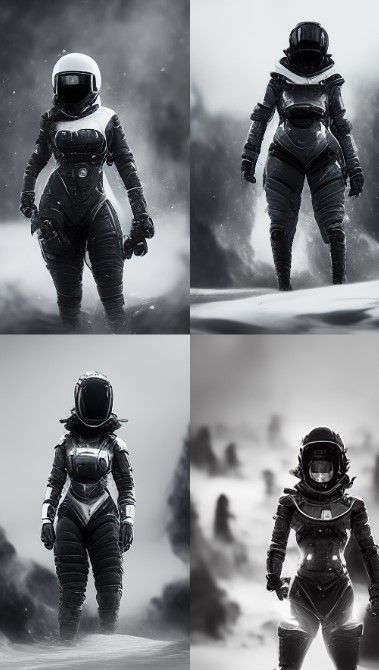
Look at those chonky boys in the bottom left.
One thing I learned is that you have to sometimes use unexpected keywords. The last group of four on the bottom right in the above set didn't use the word astronaut at all but matched what I was aiming for much more closely. I got that using "woman in space suit battle armor". By this point, it was after midnight, so I decided to wrap up my efforts for the night. I wanted one last prototype, so upscaled the first woman in space suit battle armor and sent this to my friends:

I had added some texture to the title text, added the old synopsis to the back, and plopped my protagonist in with an added neural filter to match the style (I ended up not using such a filter in the final version). To recap, I had spent just over 2 hours on this early version of the cover. And it's not far off from the final version, to be honest.
My main issue was with the character. I didn't think there was enough contrast between her black armor and the background, so a few days later I went back to generating subjects until I got this one:

Now, there's all kinds of AI weirdness going on here. What's up with her face? Where are her fingers? I don't know, man. But I liked the overall style of the outfit – it pretty closely matched what I had in mind while writing, so I went with it.
Those are the kinds of decisions I had to make: "yeah, this looks good enough", "that seems like the right color", "I like that armor." They were pretty brainless, based purely on vibes. More thought went into the placement of the text and which font to use than anything else. If you have a few hours to kill, you can create something better than this with hardly any effort.
But at the end of the day, the cover art is significantly better than the original and all it cost was $10 and maybe 4 hours total. (Photoshop isn't free, but GIMP is, and it can handle everything I did just fine.)
I think we're rapidly approaching the point where a good book cover is an even worse proxy for how much effort the author spent on the book. Creating a good book cover is going to be trivial, much easier than writing a good story. "Don't judge a book by its cover" is going to be even better advice than at present.
But... Isn't This Bad?
Like any new technology, there are tradeoffs to consider. Having the power to create badass covers at low cost is great for authors, but potentially terrible for artists whose work was just made irrelevant by this advancement.
But is their work really irrelevant? I don't necessarily think so. Does the existence of this:

Decrease the value of this?

I don't think so. The bottom one holds its value because we know who it came from: Vincent Van Gogh, an important figure in the history of art.
Nowadays, there's a lot of the same thing going on. We value good art, but we also value who it comes from. And that's only going to be amplified once AI generated art becomes more commonplace. Consider these two depictions of the Iron Throne:


The second one is by one of my favorite fantasy artists, the supremely talented Marc Simonetti. His depiction is (in my opinion) just a better piece of art, but fast forward a few years, and the AI will likely be as competent as the best artists around. I still think people will pay artists to commission custom artwork. People will be even more impressed if you do, recognizing, "Oh, you've got a genuine Simonetti!" or "Wow, an original Ortiz!"
And I hope that means those artists can still make a living selling their artwork, because part of the value of their art is that it came from them. I'm fundamentally an optimist, so I hope there's a good middle ground somewhere. Something like:
- Those who wouldn't be able to afford their commissions anyway will be able to get great cover art using AI.
- Those who can afford to commission artists will still do so because they value the artists themselves, and in a world flooded by AI art, the human-produced art is still seen as the most valuable.
I also know that the world doesn't consist only of sunshine and rainbows, so this technology may turn out to be disastrous for artists; I really hope that isn't the case. One thing is for certain: anytime something new like this comes along, the changes we have in store are unpredictable.
I would love to hear some artists' perspectives on this. I'm sure it's a hot topic in those circles right now. And if you have any thoughts on the matter, please let me know! I know for a fact I haven't considered every angle and still have much to learn.
So, that's it. If you're interested in reading Grave of the Waiting, all of the released chapters are published over at the homepage: https://joshse.com/grave. As of this release, there are 7 chapters published, which takes us to the end of Part I of the story!
If you want to start reading now, you can jump right into the story here: Prologue.
Chapters come out on the 1st of every month, so subscribe to the mailing list to get them sent to your inbox.
As always, thanks for reading!
